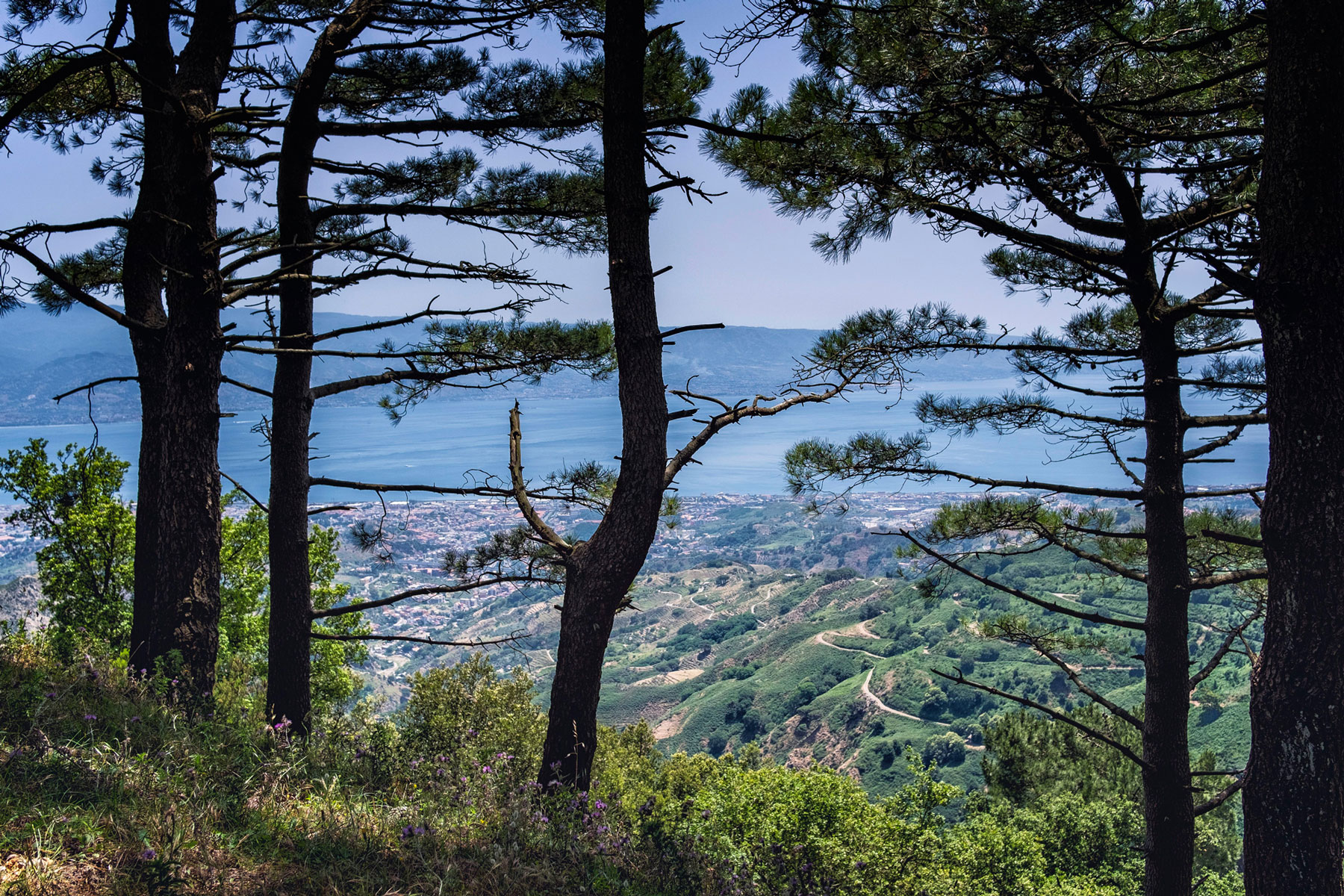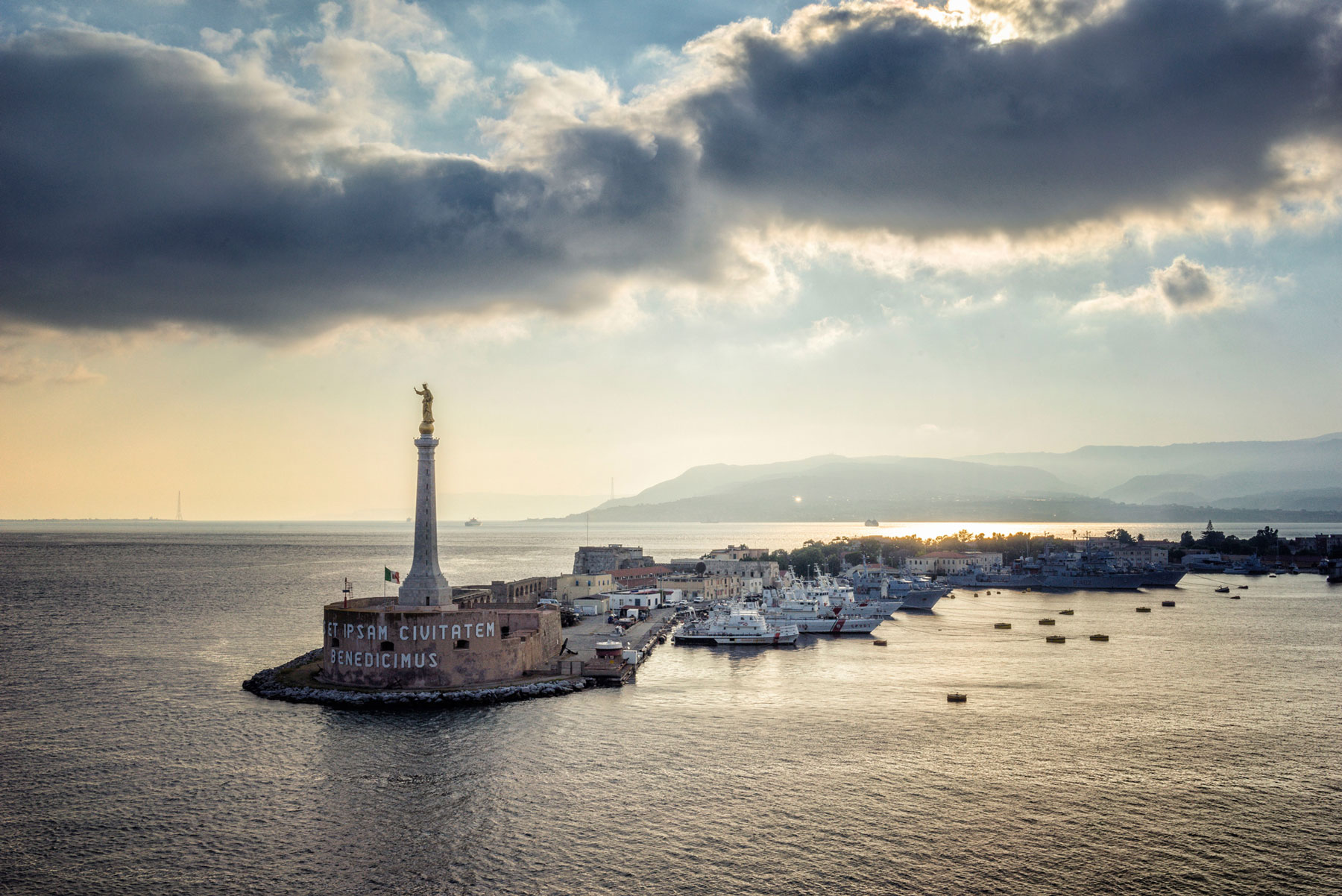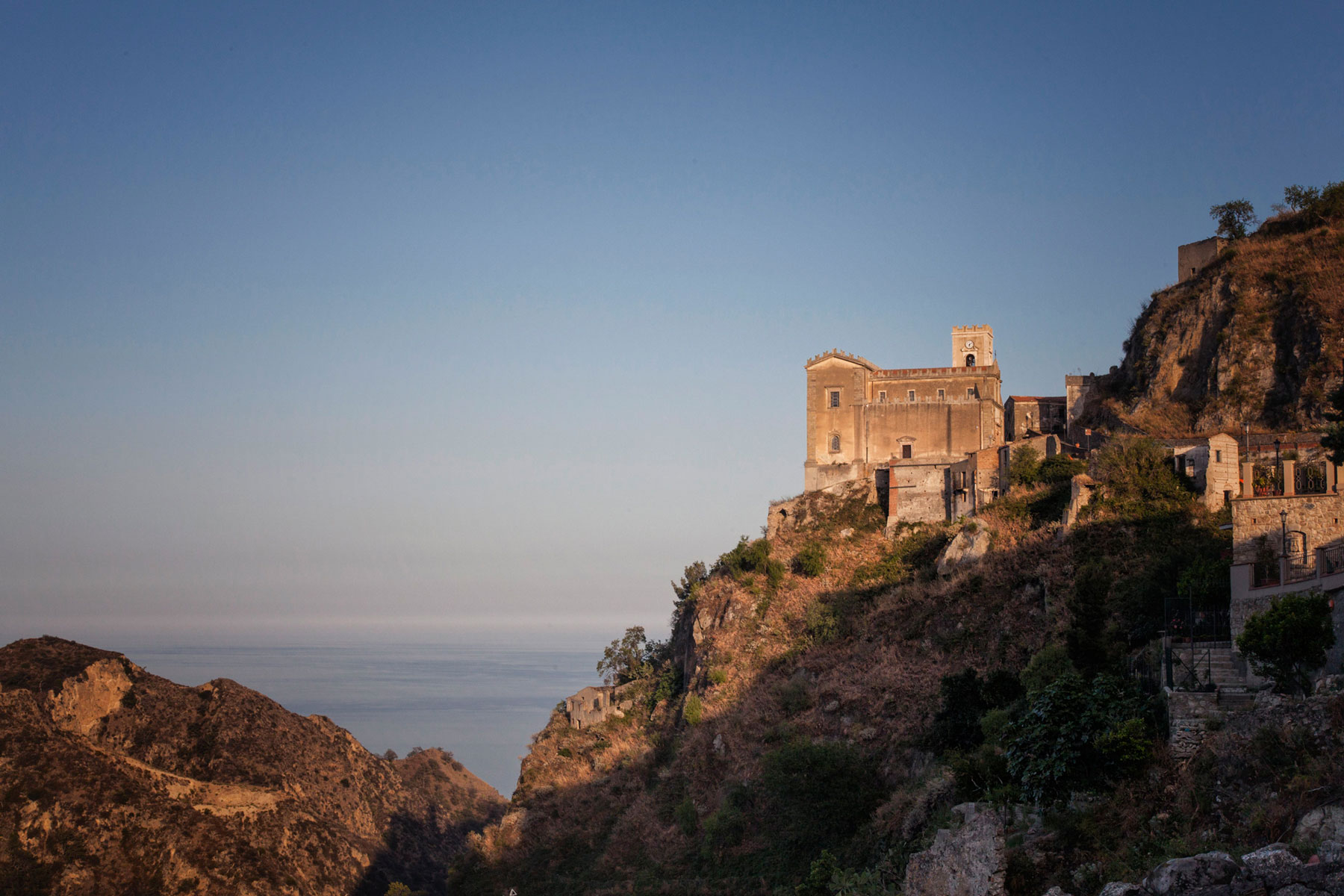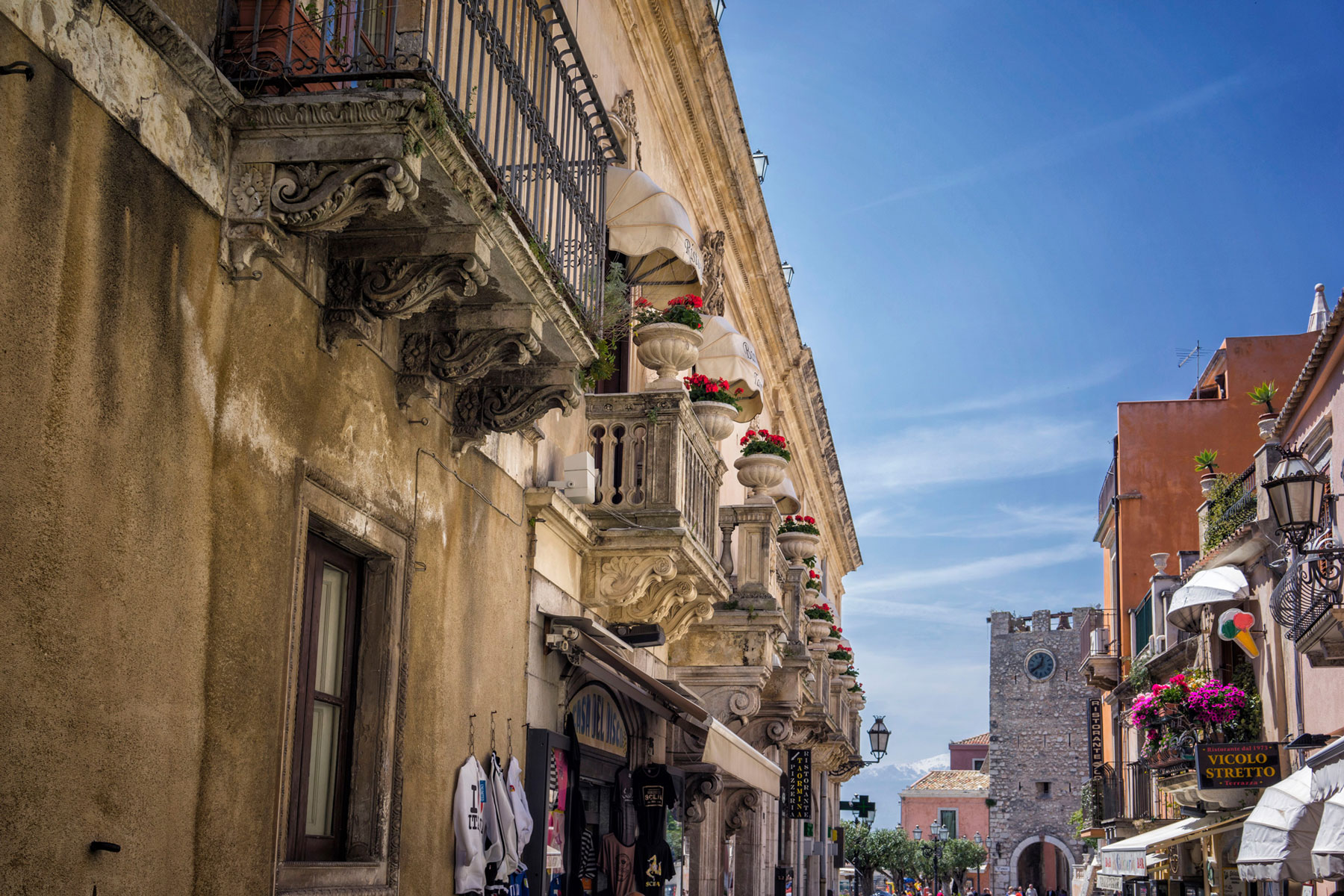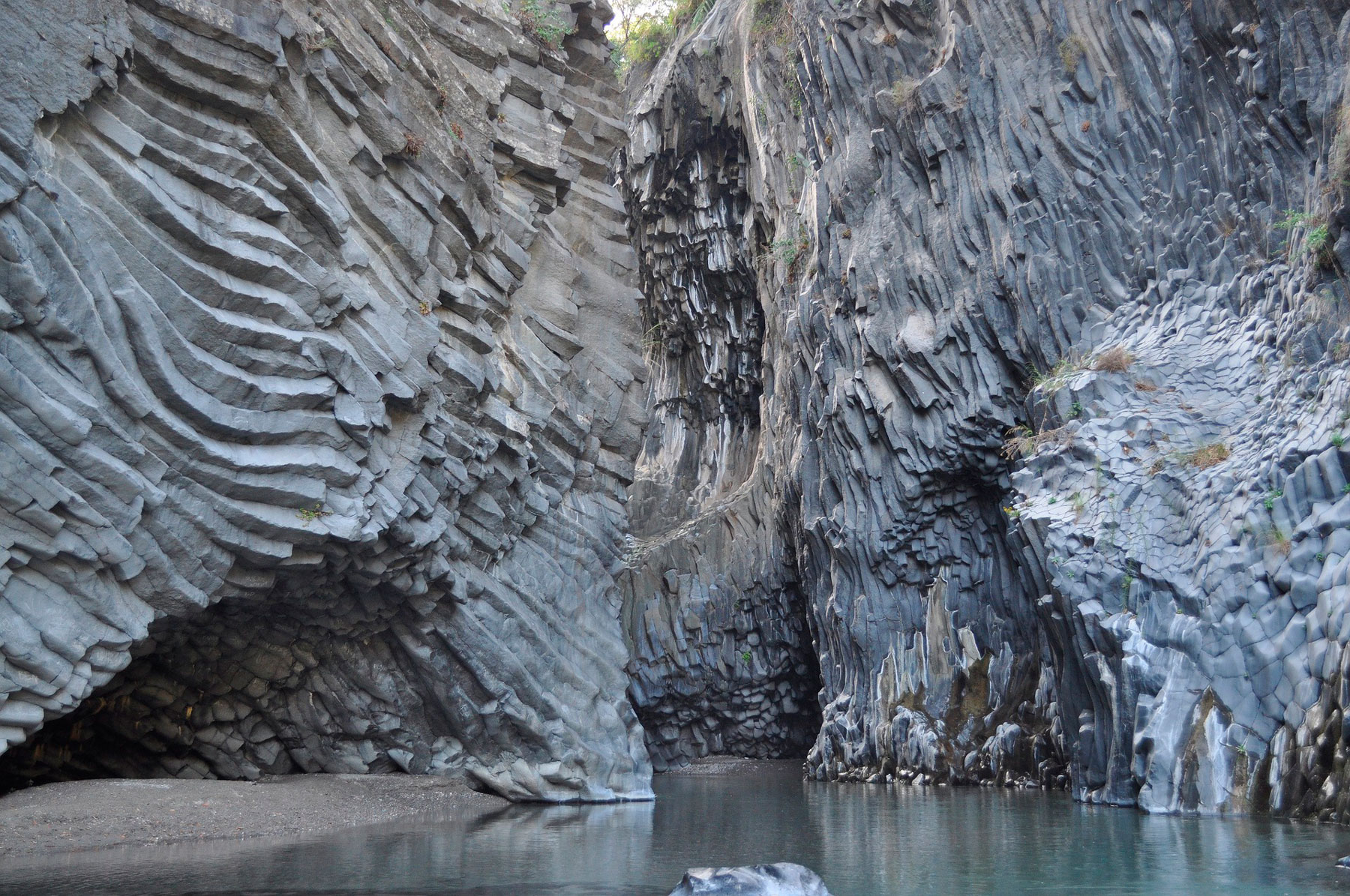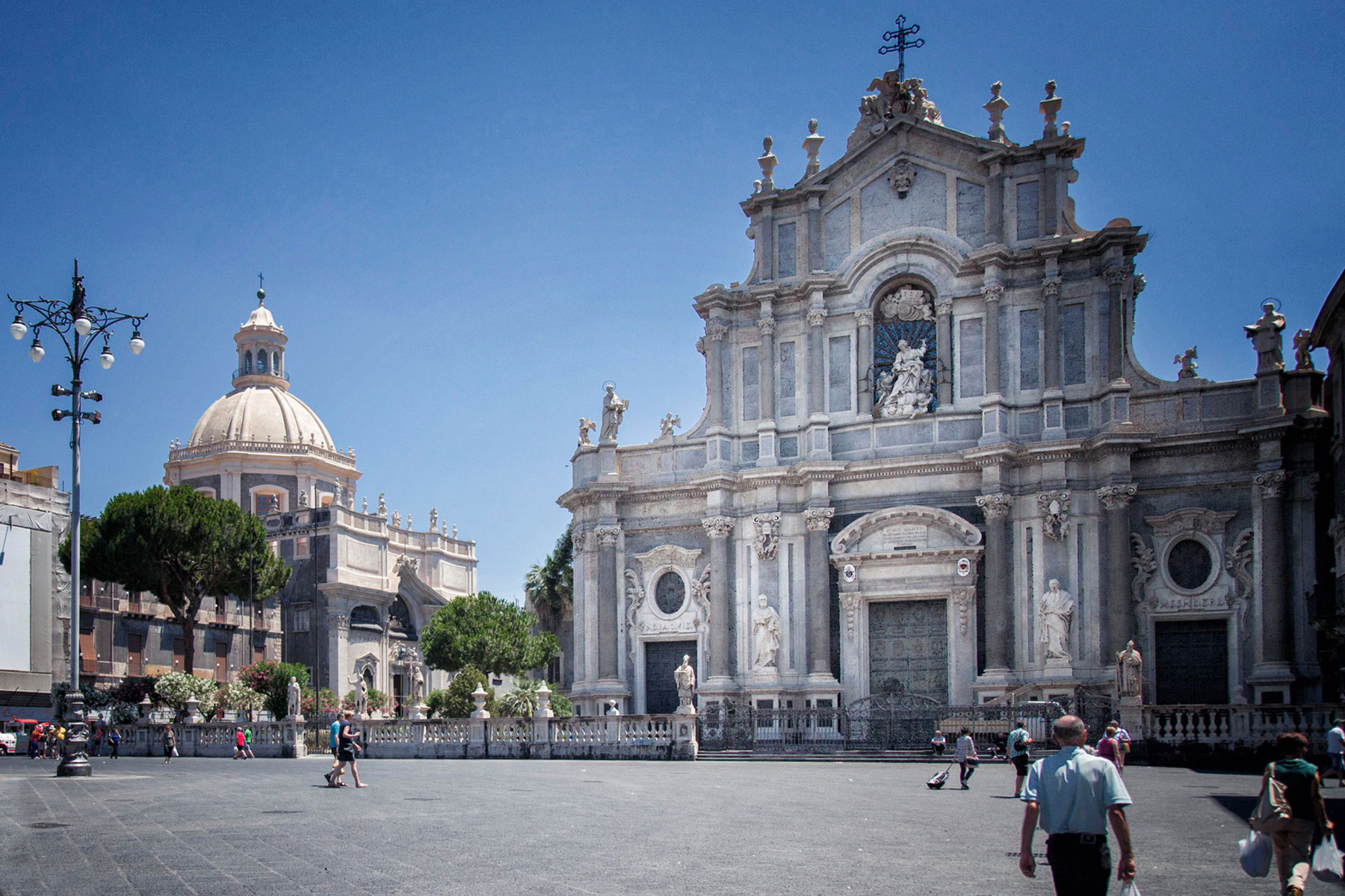Itineraries
Villa Le Zagare is located in a unique position from which to reach in a short time many destinations object of the desires of your holidays. You can choose the most different settings for daily excursions: roll down from the sand mountains of Santo Saba, stroll through the megacities of the Argimusco, immerse yourself in the Pools of Venus in Milazzo, taste a good wine of Etna surrounded From the lunar scenery of the lava stone, climb the volcano of Stromboli, take a leap into the past of Francis Ford Coppola’s Godfather in Savoca, enjoy a spectacle at the Teatro Antico in Taormina, the markets of Palermo, the history of Syracuse and Catania or Just dive into the blue of our wonderful sea. So Many other destinations are at your fingertips, you have the choice…

Palermo
cefalù
argimusco
tindari
eolie
milazzo
peloritani
messina
stretto
savoca
taormina
calatabiano
etna
catania
siracusa
Palermo
It was Phoenician city, Greek and Roman, Arab capital, land of conquest for Normans, Swabians, Frenchmen and Spaniards. Centuries of history and domination have marked the Sicilian capital, city of Thousand Faces, crossroads of peoples, amalgamation of different cultures and traditions, beautiful and immense. Palermo proudly shows the testimonies of its past that lives again in the grandeur of its artistic and architectural heritage. In the “City of delights” coexist harmoniously Arab domes, churches with Baroque taste, Art Nouveau palaces, neoclassical theatres, eighteenth-century green spaces and swarming historical markets, similar to the Arabic souks. It is No coincidence that in 2015 the historic center of Palermo has become part of the Unesco Heritage. There are Many things to see including the Cathedral, the Palatine Chapel and the Norman Palace, the Capuchin Catacombs, the Martorana Church, the Pretoria Fountain, the colourful benches of the markets and a few kilometres from Palermo, the Norman Cathedral of Monreale. Difficult to concentrate in a short time a visit to the city undeniably splendid marked by the sweetness of the climate and the extraordinary cuisine.
Palermo Cathedral | © Simona Bonanno
Cefalù
SBeautiful tourist and seaside resort, every year destination of thousands of tourists who arrive from different parts of the globe to spend the holidays. The town is set in an extraordinary panoramic position, dominated by a hill that falls to the peak of the turquoise sea, the Rocca, on which still dominates the peregrine falcon and the Mediterranean scrub is the master. The relationship between Cefalù and its Fortress has always been very narrow, so much so that, according to some historians, the same ancient Greek name of the city, ‘ Kephaloidion ‘, derives from ‘ Kefalis ‘, that is ‘ head ‘, which recalls precisely the shape of the characteristic cliff. Traces of the Hellenistic-Roman road system, a sign of the domination of the Western Roman Empire, are scattered Throughout the city. From Cefalù also the Vandals and the Goths, we find traces of the Eastern Empire, then of the Arabs and then of the Normans. Few footprints left by the Byzantines (some remains of fortifications); Only in the uses and customs those referable to the Arabs who conquered Cefalù in 858; Magnificent and monumental ones that were coming from the Normans. In the first half of 1700, opened to Europe, the town begins to be the destination of the travellers of the Grand Tour. Strolling you can admire, between the facades and the streets, glimpses and traces of every civilization. Cefalù, which is part of the Madonie Park, is included in the club of “The most beautiful villages in Italy”. The Cathedral of the city included in the site “Palermo Arab-Norman and the Cathedrals of Cefalù and Monreale” in 2015 was declared world Heritage by Unesco.
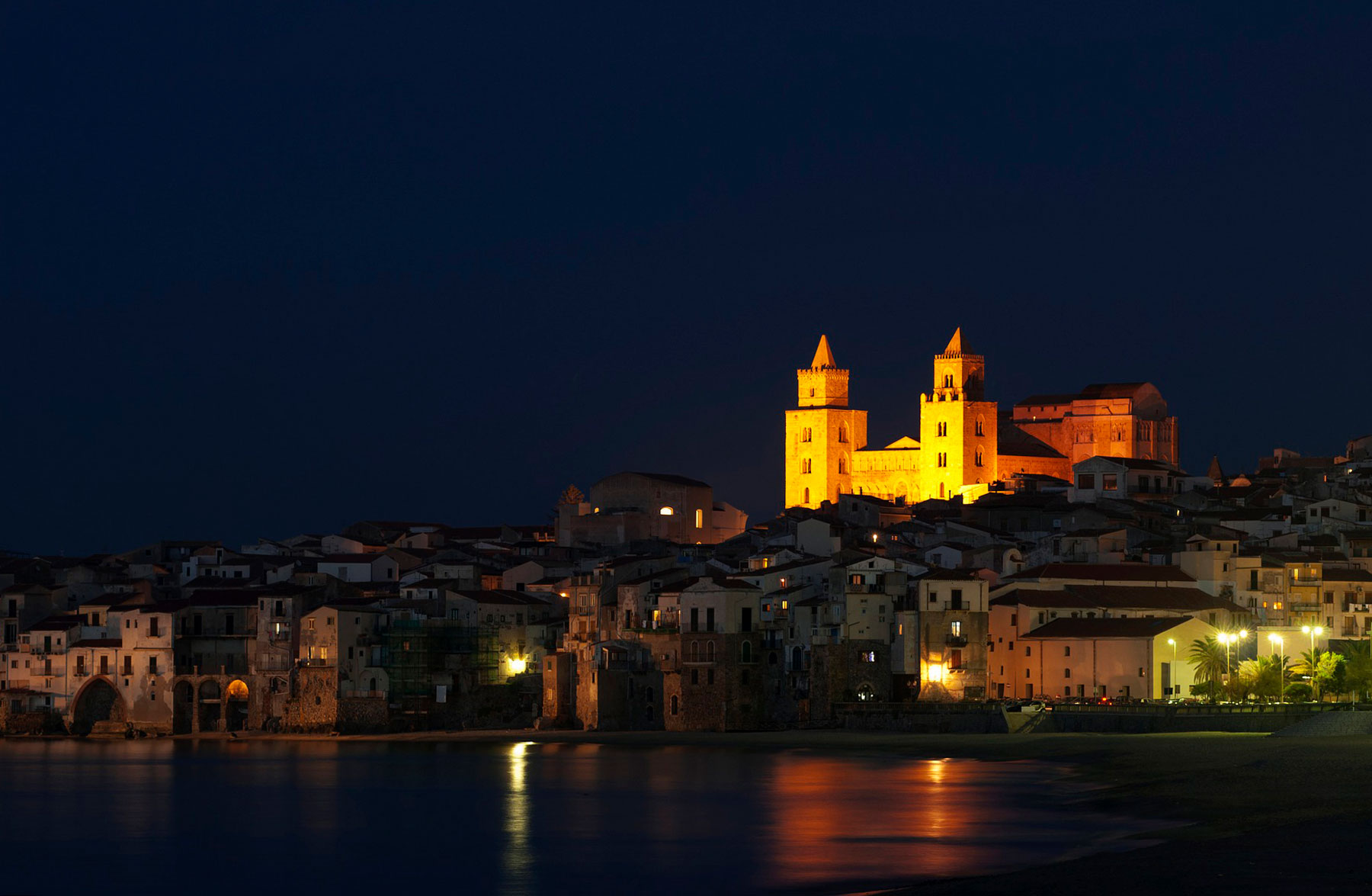
Argimusco
Candidate to become a Unesco patrimony, this site, erroneously defined the “Sicilian Stonehenge”, is a spectacular plateau in which there are numerous natural rock formations of sandstone arenite, only some of them have been worked by the hand Dell’uomo. 10 of these represent the constellations present in the summer sky, for this reason the Argimusco is called “The Mirror of the Stars“. Nestled between the Etna, the Nebrodi, the Peloritani and the sky offers a scenery that has been used, over the centuries, for purposes of observation and astronomical studies, a real natural sanctuary where in antiquity were held rites and sacred cults Related to the deities of the Earth and the heavens. The rocks are of various forms, often referable to symbolic figures: the Eagle, the Pelican, the OWL, the Serpent, the Orante and others still create in this magical place a refuge for the soul.
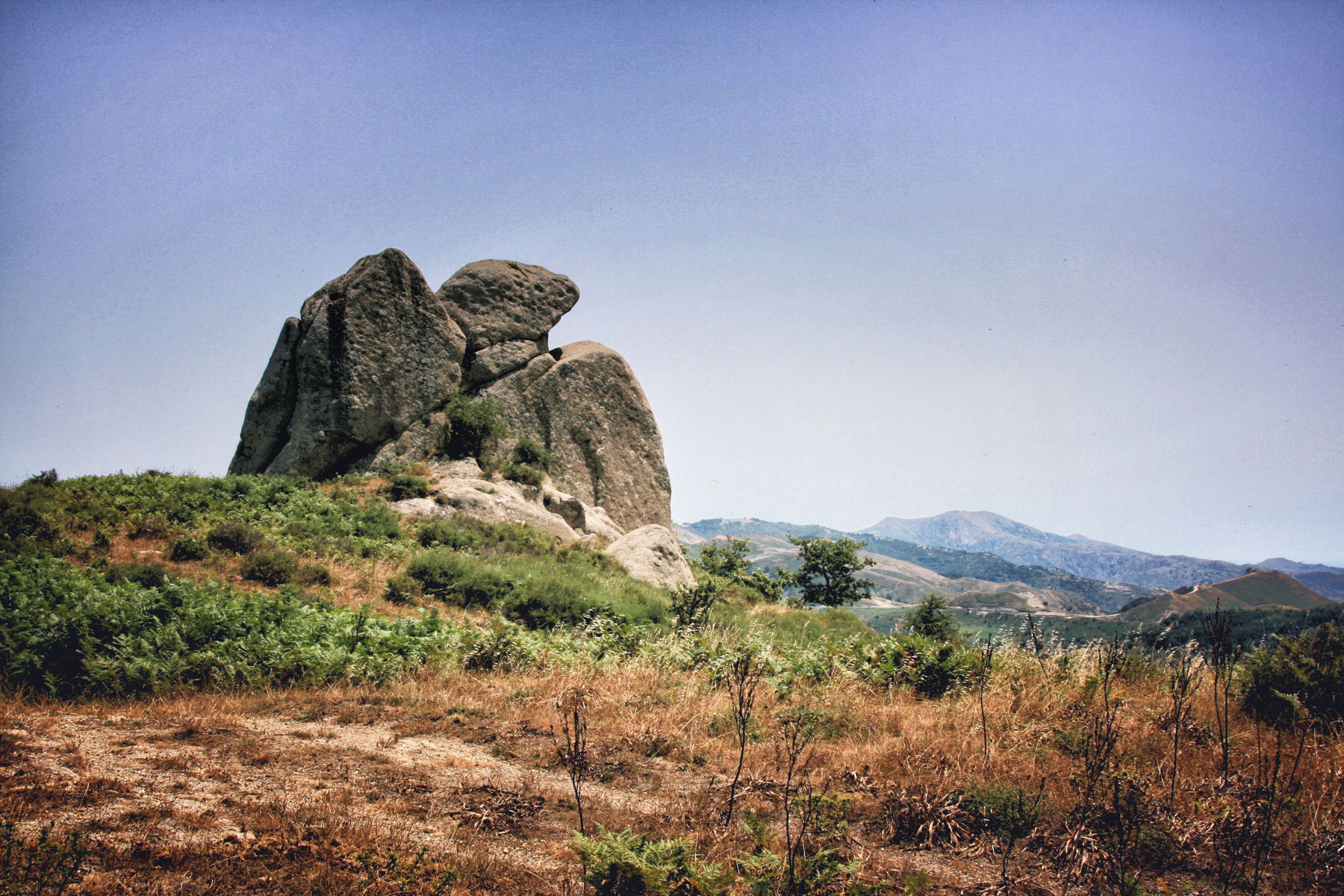
Tindari and Marinello
Founded on the site of the Sicilian center Abaceno in 396 BC by Dionigi I of Syracuse in order to establish a military outpost against possible Carthaginian incursions, Tyndaris was one of the last Greek colonies in Sicily. Grown rapidly, the city played a strategic role of great importance in guarding the Tyrrhenian maritime routes and lived all the troubled events of the conflicts between Siceliots, Carthaginians and Romans for the control of the island. Occupied by the Carthaginians, it was conquered by the Romans who defeated them. Under Augustus, it became one of the five Roman colonies enjoying all the privileges. A landslide of great proportions, an earthquake, and the devastation of the Arabs who destroyed the episcopal see established by the Byzantines, put an end to the epic of Tyndaris: but its beauty survived. The theater, built at the end of the 4th century AD, was completely renovated and transformed into an arena during the Roman era, with the demolition, unfortunately, also of the structure of the scene. The remains of the Basilica (I century BC), of the baths (II century AD) with their mosaics and Roman houses with courtyards and columns dating back to the imperial period complete the archaeological area surrounded by large tracts of ancient walls.
The Sanctuary of Madonna di Tindari rises on the site of the ancient agora, right on top of the cape Tindari. It is a pilgrimage destination due to the effigy of the Black Madonna. The origins of this statue are tied to a legend, according to which, the sculpture was found on board of a boat that, having landed to Tindari, it was not able to leave again. Once the sailors had deposited the cargo, including the statue, the ship managed to regain the sea. The statue was immediately carried on the hill inside a small church that became ever larger in order to accommodate the many pilgrims. The Sanctuary, as we can see it today, is located on a promontory overlooking the sea, near the ancient acropolis, where a small church had been built. The statue of the Black Madonna is carved in cedar wood and probably comes from the East. The Church was destroyed in 1544 by Algerian pirates and then rebuilt a few years later. Every year, on September 7th, the Sanctuary Festival takes place. Going down towards the sea, the Oliveri Lagoon is very fascinating, today a nature reserve. Formed by sand and gravel shorelines and three lakes: Verde, Marinello and Vergolo. Various legends are related to this beach and one of the most famous tells that the beach was formed following the fall of a child from the terrace of the Sanctuary above. On the ridge overlooking the beach there is a cave that according to another legend was inhabited by a sorceress who attracted sailors and then devoured them. When her spells did not work the sorceress vented her anger by piercing the rock walls with her fingers and this would be due to the small holes that are found on the walls of the cave. In addition to the legends, this beach is also talked about for its beauty. The nearby beach of Marinello is the starting point for exciting snorkeling or scuba diving excursions along the beautiful bays of the Gulf of Patti. After a day of cultural and naturalistic tourism, nothing better than a dinner with tasting of the wines of the Mamertino Doc area.
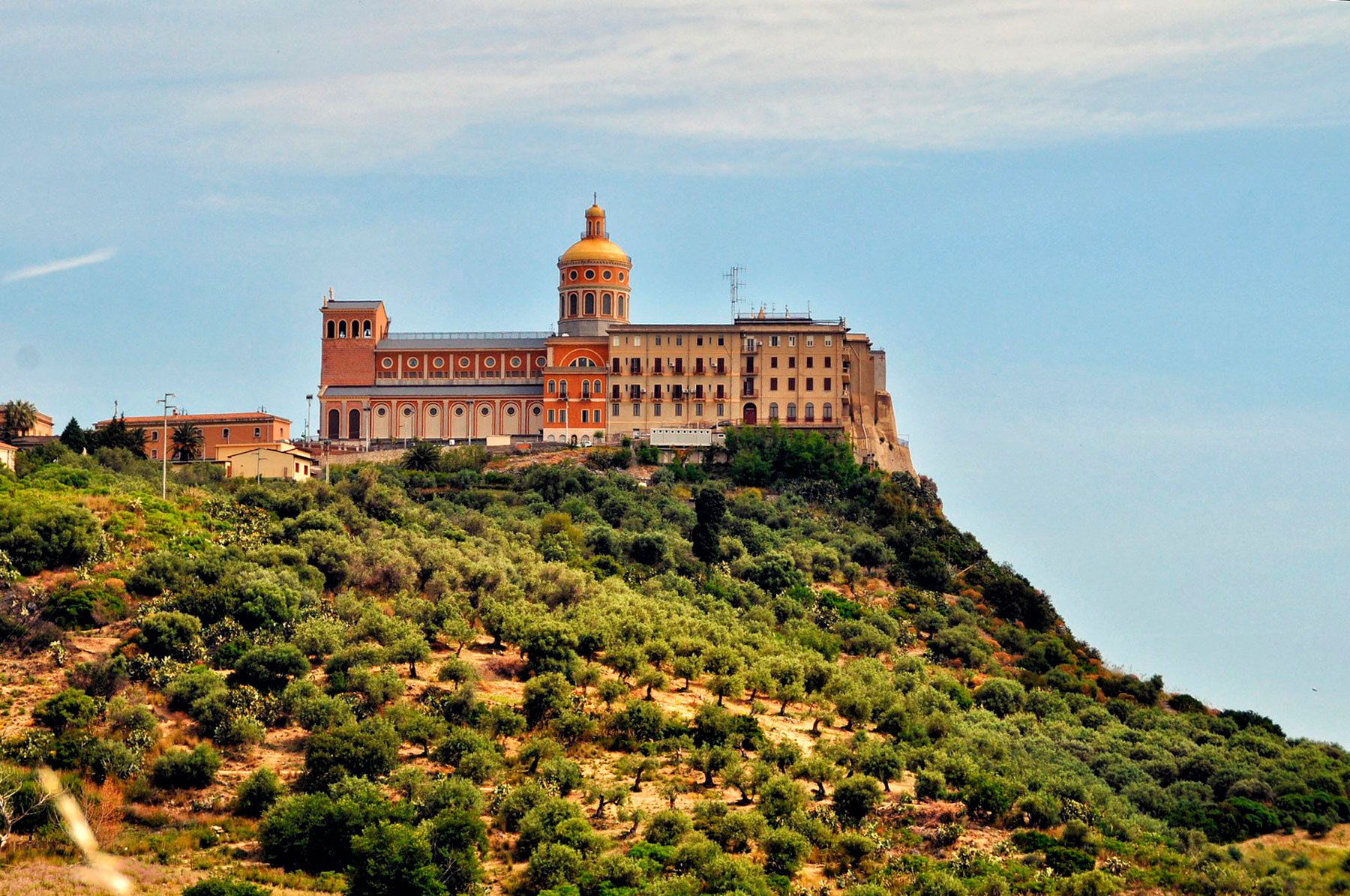
Eolian Islands
On the routes of the mythical Ausoni, to the north-east of the Sicilian coast, the Aeolian archipelago spreads its seven enchanted islands in a fan shape. The Aeolian Islands, since remote antiquity, were colonized by populations interested in the exploitation of obsidian, an insuperable material for manufacturing cutting tools. Between the 16th and 14th centuries BC, the islands became an important commercial stop on the way to metals, particularly on the route of the pond, which from the British Isles descended to the East, passing through the Strait of Messina. Subsequently, in Roman times, the archipelago prospered on the trade of sulphurs, alum and salt, gradually decaying, until it was finally abandoned, determined by further volcanic eruptions and by its designation, born from the Second Council of Nicea, to home of the devil and the place of the physical manifestations of this disturbing presence. In Norman times there was a progressive repopulation of the islands that started to live a real season of splendours. Proclaimed in 2000 by UNESCO as a World Heritage Site, the Aeolian archipelago consists of seven islands: Alicudi, Filicudi, Lipari, Panarea, Salina, Stromboli and Vulcano. All seven are islands of volcanic origin, but only the volcanoes of Stromboli and Vulcano are still active.
Vulcano still appears as a relic from the prehistory of the world, perpetually fumigating between billowing gas and mud. The eruptive vent rises to 386 meters high, where the crater, reachable without too much effort, overlooks its ridge to dominate the ports of Levante and Ponente and the Valle dei Mostri. On the coast, to the north west of the island, the imposing Grotta del Cavallo opens up along the wild and semi-deserted coast that gently slopes towards the black beaches of Gelso dominated by the scrub of euphorbia and twisted vegetations of prickly pears.
Lipari, whose lively and picturesque port is dominated by the Riolithic fortress on which the ancient Cività stands, has always been, the heart of the archipelago. Its Archaeological Museum, one of the most interesting in the Mediterranean, preserves the innumerable testimonies of the five thousand years of civilization perfectly legible in the open-air excavations enclosed between the mighty ramparts. On Lipari a volcanological itinerary is required, played between obsidian flows and white expanses of pumice. Unparalleled are the views that, from the heights of Quattrocchi, are enjoyed towards the monumental cliffs of Perciato, guarded by the scenic backdrops of the faraglioni beyond which the gaseous and sulphurous fumes of Vulcano rise. The historic center is a lovely Umbertine drawing room with light windows and balconies like lace from which balustrades descend multicolored cascades of geraniums and delicate carnations.
Salina owes its name to an ancient salt pan, but in the past it was called Didyme, that is a twin, in Greek, in relation to the two characteristic volcanoes that can make the island look like double from afar. Here we must not forget a visit to Monte Porri and Monte Fossa delle Felci. In the latter, at almost one thousand meters of altitude, the ancient crater was colonized by gigantic aquiline ferns that add to the luxuriant vegetation of Salina, giving it a typically tropical appearance. Unique scenario is the submerged crater of Pollara.
Not far from here, Filicudi and Alicudi, stand out against the horizon. Both distant from the clamor of assault tourism, the two islands offer spaces of abandonment and meditation unthinkable to the noisy latitude of our civilization. Near the Canna, seabed rich in sponges and corals offer unexpected scenery for underwater photography enthusiasts.
Another place of great charm, in the archipelago, is constituted by the basalt rocks of Basiluzzo, Dattilo and Lisca Bianca that face Panarea, with which, as Strabone narrates, they once constituted a single island, Evonimos, which a cataclysm disappeared in those current. Monumental solitudes characterize this group of rocks in the vicinity of which, from imposing mouths of submerged fumaroles, bubbling bubbles of gaseous vapor rise up which, in antiquity, were probably the site of a cult dedicated to Hefesto. Panarea, the smallest of the Aeolian Islands, represents its flagship.
Continuing towards north-east, Stromboli stands out, the land of “Iddu”, the volcano, as the islanders call it. the island surrounded by black sand still preserves an almost mystical atmosphere, it is a magnet for hikers and scholars or simply for those who wish to enjoy a vacation away from the summer frenzy while being kissed by the warm sun of Sicily. The sea is dark and deep. At night from the boats it is possible to see and feel the activity of the volcano that lets down hot embers of lava that boil on contact with water along the sciara.
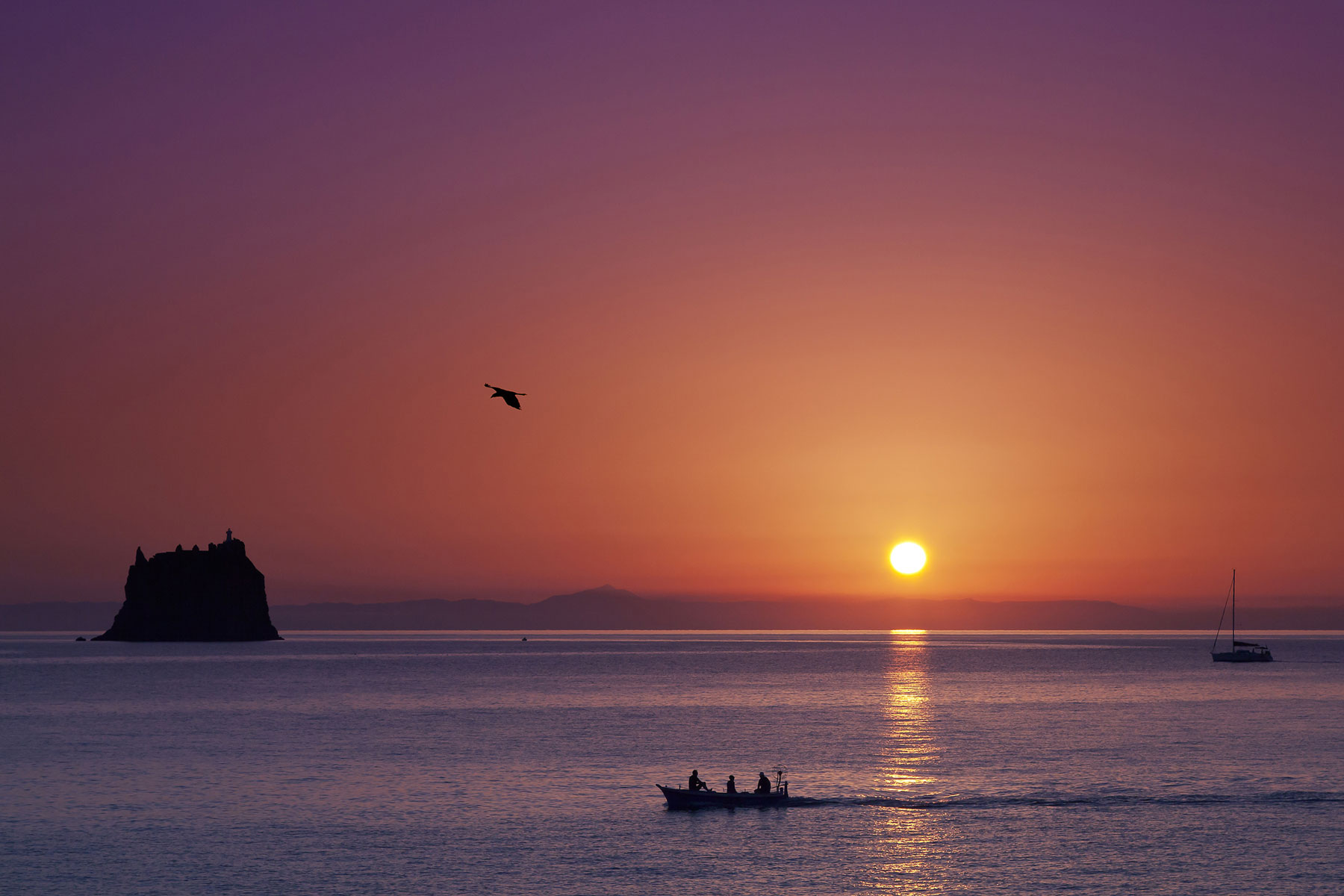
Strombolicchio seen by Stromboli | © Simona Bonanno
Milazzo
Milazzo was called the “peninsula of the sun” by the Myth and placed the herds of God and the cave of Polyphemus visited by Ulysses on its banks, right in front of the Islands of the King Aeolus guardian and ruler of the winds.
And always here the story crossed the destinies of the Roman Consul Caio Duilio who defeated the Carthaginians at sea and Octavian who defeated Pompey, opening the century of maximum splendor and power for Rome. Frederick II of Swabia erected one of his most important castles which today is the largest in all of Sicily. Giuseppe Garibaldi who ultimately conquered Sicily slept on the steps of the church of Santa Maria Maggiore, eating bread and onions as the commoners of the maritime district of Vaccarella used to tell.
Today Milazzo is a strip of land that stretches out into the lower Tyrrhenian Sea for about seven kilometers towards the Aeolian Islands, for which it has always been the natural and privileged starting port.
The beautiful Castle, a national monument, dominates the isthmus that connects the Borgo, ancient village of Milazzo with the Piana. The fortification began under the Arab rule between the 9th and 10th centuries. in the place that had been an acropolis at the time of the Greeks, modified and extended over the centuries. It took on the appearance of a real fortress following the interventions of Federico II di Svevìa. The complex that we admire today is the result of centuries-old transformations that over time have seen Greeks, Romans, Byzantines, Arabs, Normans, Swabians, Angevins, Aragonese, Spanish, English …
Today the art and craft school is located inside the castle. Skilled hands, ancient techniques, passionate craftsmen continue a happy tradition. From the top of the castle you can enjoy a beautiful view of the Tono bay, the Cape, the town and a beautiful sunset over the Aeolian islands.
The one in Milazzo is one of the busiest commercial and tourist ports in the Tyrrhenian Sea and is also the optimal place to start your tour of the city center or from which to go on trips to the Aeolian Islands by private boat and skipper. Continuing to walk you reach the marine district of Vaccarella rich in typical and tourist places.
Ponente beach, long, sunny and served by numerous beaches, is the first beach that you meet moving away from the city center. Heading towards the inlet of the Tone begins the Cape promontory. From here to our view we offer more than 10 km of ravines, caves, coves, beaches, legends that culminate in the pools of Venus, a corner of paradise placed at the end of the cape and reachable both on foot and by sea.
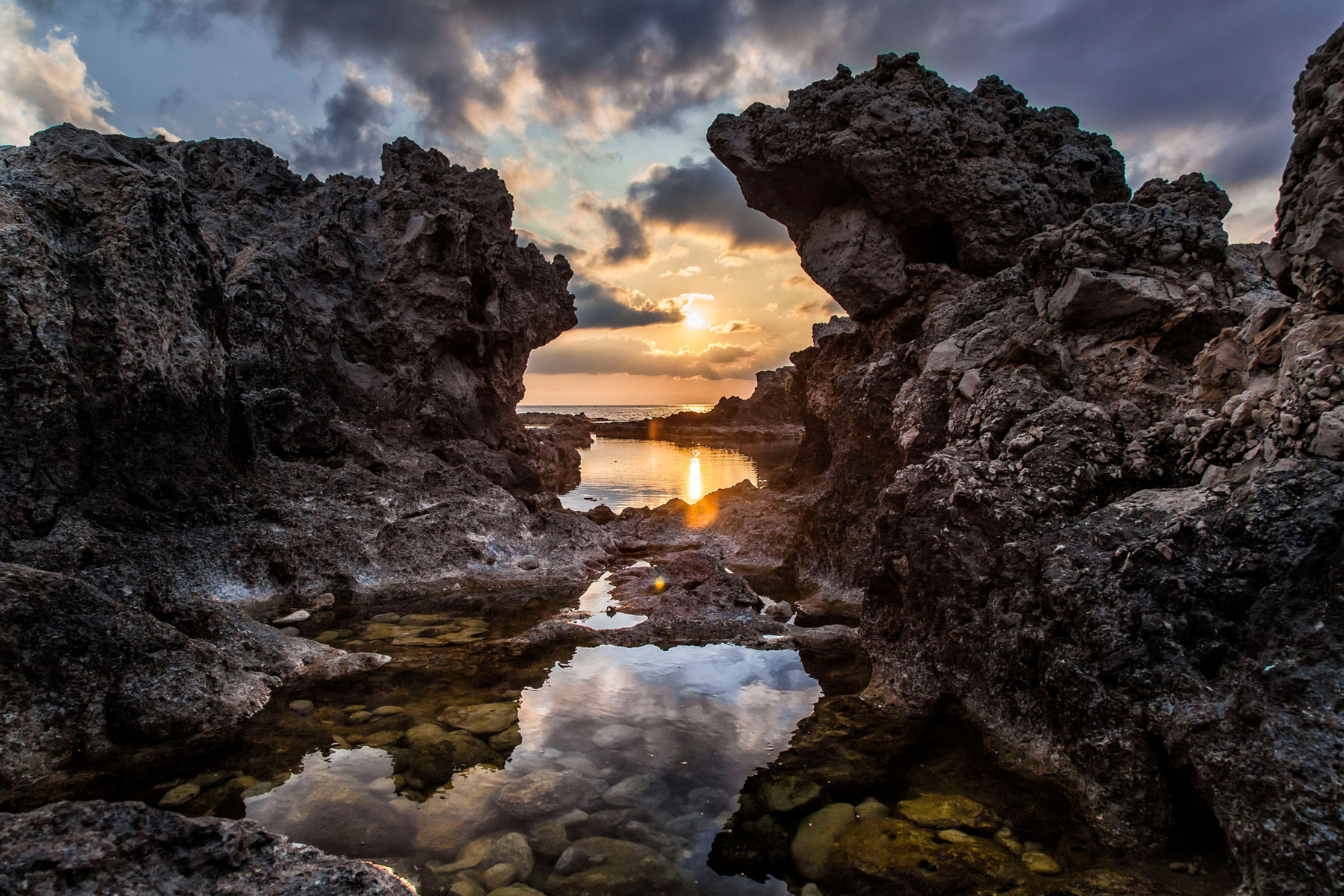
Peloritani Mountains
The Peloritani Mountains constitute the easternmost section of the northern Sicilian chain and are thus named by the Pelorus mons of the ancients, from which comes the name to the well-known promontory Capo Peloro, otherwise called Capo Faro. It represents the easternmost summit of Sicily, located at the northern end of the Strait of Messina and is 3 km from the Calabrian coast. The Peloritani Mountains reach the highest heights with Monte Poverello (1279), with Monte Scuderi (1253) and with the Antenamare (1130); then, more and more declining, they end towards the Capo Rasocolmo and the village of Spartà with less acute forms. On the Peloritani there are forests of oak, holm oak, cork oak, pine and chestnut. In the most inaccessible areas small strips of natural oak and holm oak wood or Mediterranean scrub with broom predominance have been preserved. The attractions of a trip on the Peloritans are many: walks in the woods with possible stops in the many equipped areas, bird watching, “walks” on the trees in the “Peloritani Mountains Adventure Park”. Here it is possible, in total safety, to pass from one tree to another thanks to suspended platforms, steel cables, Tibetan bridges, Tyrolean bridges, ropes and ladders, testing one’s balance and concentration together with a little of physical exercise. At the end of a day on the Peloritani the view from the Antennammare and the visit to its small Sanctuary, from which it is possible to admire Mount Etna, the Ionian coast, the Strait of Messina, the Tyrrhenian coast and the Aeolian Islands from a single point of view, even better at sunset.
Strait of Messina seen by Peloritani Mountains, Messina | © Simona Bonanno
Messina
TrAmong the first Hellenic colonies of Sicily, Messina, the ancient Zancle, or “sickle” due to the singular shape of its port, was founded by the colonists from Cuma and Calcide, around 756 BC His historical story will, from then on, always be connected to the economic-strategic importance of the site: conquered and re-conquered by Sicelioti and Cartaginesi, it will then be the first Roman colony in Sicily and will reach a position of great importance, so much to be defined by Cicero “Civitas maxima et locupletissima”. Protometropoli with the Byzantines, rich and opulent with the Normans, an important Angevin military port: this period of splendor will last several centuries, during which the political importance and the great urban-monumental development will counterbalance the splendor of culture, so that literati and humanists, thinkers and artists will flourish, on which the name of Antonello stands out. Then the Spaniards, the plague of 1743, the terrible earthquakes of 1783 and 1908 (which destroyed 90% of the town) and the Allied bombing of 1943, reduced the role. Once the city was rebuilt, the people of Messina were able to recover even a large part of the historical, monumental and artistic heritage, giving them back the role that belongs to the city of Antonello. Devastated in the earthquake of 1783 and razed to the ground in that of 1908, Messina contains two cities in one. From the Middle Ages to the Renaissance, from the Baroque to the nineteenth century, nine centuries of art history still show their sumptuous remains. Rebuilt between 1912 and the 1930s, the new Messina offers a sober and elegant image, characterized at the same time by the exuberance of original decorations. In this way we meet stately buildings of eclectic lines, Gothic and Neo-Renaissance, neo-baroque and neoclassical forms, freely contaminated by liberty and Moorish motifs, classical buildings, in pure rationalist style. The urban decor of Messina was enriched with numerous and sumptuous sculptural complexes that began in the 16th century. Among these are the Fontana di Orione (which represents one of the mythical founders of the city) and the Fontana del Nettuno, which represents Neptune which calms the sea of the strait, both of Montorsoli.
The Duomo, a beautiful Norman building, built in 1160 under the reign of King Roger II and remodeled in the 1300s and 1500s, is one of the oldest churches in Sicily and is a symbol of the misfortunes of the city of the Strait but also of the desire of the Messina never bend before the inevitable. Already in the thirteenth century it was the victim of a violent fire, then of the earthquakes of the seventeenth and eighteenth centuries, almost entirely destroyed by that of 1908 and, once again rebuilt, heavily damaged by American bombs, in 1943. Today it preserves three magnificent magnificent facades portals of the fifteenth and sixteenth centuries. Adjacent to the temple is the beautiful bell tower, rebuilt several times, which houses the largest astronomical clock in the world, built in 1933 in Strasbourg: composed of numerous animated dials indicating hours, days, months, planets and religious holidays, it gives rise to noon to a real musical and animation show. Entertainment not to be missed, as well as the ascent to the bell tower itself (65 m.)
In the city center there are the remains of the church of Santa Maria d’Alemanna, very important as they are the only sign of Sicilian Gothic architecture. The temple was built in the first half of the 13th century for the Order of the Teutonic Knights.
The Church of Santa Maria Annunziata dei Catalani is one of the most precious treasures of Messina. Built in the second half of the 12th century during the reign of the Normans, probably on a pre-existing temple, it is characterized by a simple and elegant thirteenth-century façade, in which there are three portals, with a dome and splendid apses. An elegant example of a successful fusion of styles – Byzantine, Romanesque, Arabic and Norman – the temple has a three-nave interior on columns with a barrel vault and a cross and the dome resting on Byzantine plumes.
The Pinacoteca of the Regional Museum hosts three absolute masterpieces: the ‘Polittico di San Gregorio’ by Antonello da Messina (1473), the ‘Adoration of the shepherds’ and the ‘Resurrection of Lazarus’ by Caravaggio (1608-9).
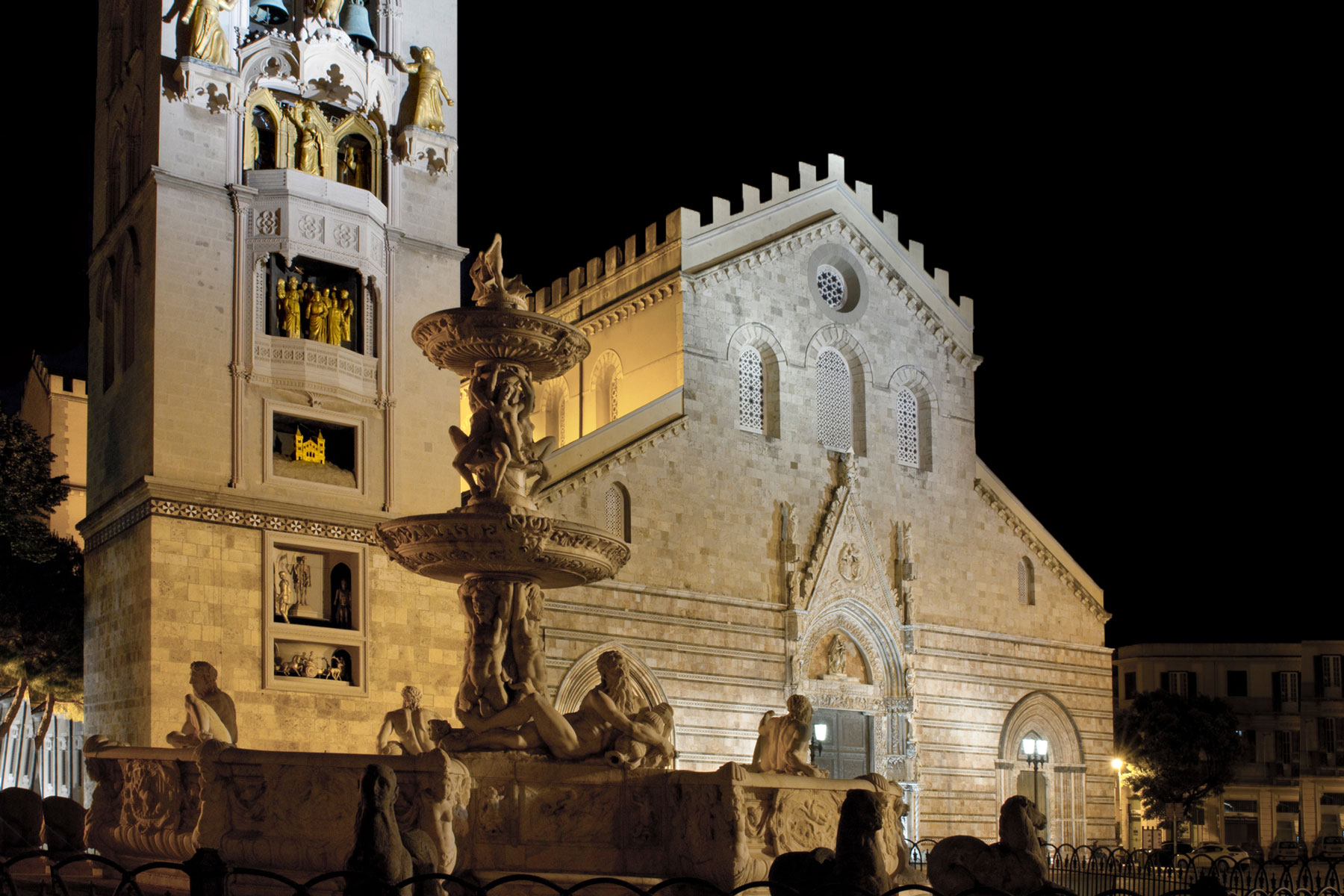
Strait of Messina
The Strait of Messina is a stretch of sea that connects the Ionian Sea with the Tyrrhenian Sea and separates Sicily from mainland Italy. It is the point of separation between two basins, Ionian and Tyrrhenian, contiguous but distinct physiographically, having waters with different physico-chemical and oscillatory characteristics, cause of strong opposing currents that provoke suggestive and surprising hydrodynamic phenomena. The Strait of Messina, being along one of the main migratory routes of the Mediterranean Sea, is a fundamental transit point for the migration of numerous animal species. The best known and most important are the large pelagic species, ie tuna, alalunga, bonito, imperial needlefish and swordfish. The hydrodynamic characteristics and the “richness” of the Strait determine the transit in surface waters of these fish that can be captured with the particular boats called feluccas or walkways, active only in this part of the Mediterranean Sea. In the manifold variety of fish present the most appreciated is the swordfish that arrives there, every year between March and July from the distant polar regions to lay its eggs. That of swordfish is a very characteristic peach practiced in the ancient way of the Phoenicians. You can organize a day on the felucca to watch the fishing. The evocative hydrodynamic phenomena of which we spoke have fueled a rich mythology: Omero, in the Odyssey, spoke of Scilla, sweet girl in love with Glaucus, transformed by Circe into a terrible six-headed monster. The monstrous figure, instilling fear in the sailors who tried to approach the coast, unleashed tremendous storms. On the Sicilian side of the Strait there was Charybdis, transformed by Jupiter into a terrible monster because he was guilty of having stolen the oxen from Hercules. The myth of Scylla and Charybdis, as well as from Homer, was sung by Dante, Virgil, Ovid. On the Strait of Messina it is possible to practice all water and underwater sports in a suggestive setting and participate in swordfish fishing trips. Exploring the Tyrrhenian coast, between Villa Le Zagare and Punta Faro, numerous magnificent beaches meet. These include the Capo Rosocolmo beach, famous for its Sand Mountains. The point of arrival of the exploration is the beach of Capo Peloro where the Tyrrhenian and Ionian seas meet and you can enjoy a breathtaking view of the Strait of Messina with its eddies and of Torre Faro, a charming fishing village.
Stele of the Madonna della Lettera in the harbor of Messina | © Simona Bonanno
Savoca
Perched on a rocky hill, surrounded by citrus groves, vineyards and olive groves, lies the town of Savoca, a small medieval village that in 2008 was included among “The most beautiful villages in Italy”. Here the time seems to have stopped, one almost has the feeling of having been catapulted into the past, about 50 years ago, when the cars still didn’t circulate and life ran slowly and harmoniously. A walk along the semi-deserted streets of the historic center, surrounded by ancient buildings, opens the door to panoramas that cannot leave you indifferent: your gaze sweeps through the immense and verdant woodland, until you lose yourself on the horizon over the sea. All accompanied by an almost mystical peace and silence, as if to reconcile admiration for the splendid spectacle of nature. The town is known for the seventeen mummies kept in the crypt of the Capuchin Convent, the three churches and the small museum, but the main attraction is the connection of the village with the film “Il Padrino” by Francis Ford Coppola. Several scenes from the film were filmed in this small village and enthusiasts along with regular tourists venerate it as a reliquary.
Panorama with view of Santa Lucia church, Savoca | © Simona Bonanno
Taormina
Taormina is located 200 meters above sea level and dominates a panorama from which you can admire the Ionian and Etna, the largest volcano in Europe. An amazing view that makes you fall in love at first sight. The town is a succession of charming streets, squares and palaces. The origins of the city can be traced back to prehistoric times: in the late Bronze Age a group of Sicilians settled on top of a hill facing the sea on the Ionian coast of Sicily. In the small urban center of Tauromenium they found refuge in the 5th century BC the inhabitants of Naxos, destroyed by Dionysius I of Syracuse who occupied it. Followed the events of Greek and Roman Sicily. With the Byzantines, its fate, somewhat fallen, rose again, and was one of the last cities to succumb to the Arabs. Islamic domination was always poorly tolerated, so much so that citizenship arose twice. After the second revolt the destruction of the city was decreed, of which only the fortification to protect Naxos, called Tambermin, survived. In the thirteenth century, following the founding of some convents, Taormina too was reborn to a new life, while still remaining little more than a village. His fortune began in the nineteenth century, when, after the visit of Goethe who sang its beauties throughout Europe, it became almost a must among the stages of the “Grand Tour”. The main city monument is the Ancient Theater, not only for its intrinsic artistic value, but also for the scenic location in which it is located. It is the second ancient theater of the island after that of Syracuse and was built in the Hellenistic period. Modified and enlarged, it was later used by the Romans for venationes and gladiator fights. The theater, whose acoustics are remarkable, is used for musical and theatrical performances in the summer season, and hosts the “Taormina Film Festival” which takes place in June. The Romans are also responsible for the Naumachia, one of the island’s greatest Roman monuments. It is a large terracing, which protected a now non-existent cistern, in which apparently naval battles took place there. Palazzo Corvaja, built in 400 on a structure from the previous century, was the seat of the Sicilian Parliament in 1410. On the front develops a band on which a series of moral sentences were engraved in Latin. Higher up, on the first floor, large double lancet windows open. The inner courtyard is very picturesque. The Duomo, dedicated to San Nicola, was built in the 13th century on the square of the same name. In the following two centuries it was remodeled. In the square and severe aspect it recalls the Norman cathedrals. The elegant Palazzo dei Duchi di Santo Stefano, built between the fourteenth and fifteenth centuries, is a fine example of Sicilian architecture. The mighty perimeter walls are lightened by mullioned windows, four below and four more elegant on the noble floor. Considered a pearl of the Sicilian sea, Isola Bella, one of the natural reserves that deserve to be visited, is a small island rocked by the sea and connected to the land thanks to a long strip of sand. Difficult not to worship her after visiting those coasts and crystal clear water. The structure of the island is more unique than rare, as demonstrated by the composition of the rocks and the vegetation developed despite the reduced space.
The Corso, main street of Taormina | © Simona Bonanno
Calatabiano castel and Alcantara gorges
The Castel of Calatabiano ises on a hill 220 m high s.l.m. and dominates the mouth of the Alcantara river.
The first certain documentation relating to the castle of Calatabiano can be seen from a map of Sicily in which the Arab geographer and traveler represented the island and its fortified systems. During the period of Arab domination the Castle was called Kalaat-al-Bian and it was probably this denomination that misled historians who dated the site as Norman Arab Castle. The site actually has very ancient origins, as evidenced by the recent historical-archaeological discoveries that date it back to the first Greek colonial migration from the 3rd century BC But it is supposed from the numerous artifacts and archaic pottery fragments that the monumental site of Calatabiano had been alive since the prehistoric period, architecturally and culturally interpreting all the transformations that the ancient civilizations of the Mediterranean brought to it over the millennia. To allow visitors to reach the castle in just two minutes, a panoramic and very modern inclined lift was installed in a gorge of Monte Castello overlooking the Alcantara river.
The Alcantara River owes its fame precisely to the particular lava formations visible today in various sections of its course. In prehistoric times its riverbed was affected by the invasion of imposing lava flows coming from Mount Etna. These flows reaching the ancient river bed have repeatedly blocked or modified the course. And it is precisely thanks to the interference between the incandescent, fluid and smoldering lavas channeled first, and then slowly cooled along the watercourse, that the Alcantara River has become a destination of great attraction for the wonderful Gorges of Larderia (most known as Gorges of the Alcantara) surrounded by prismatic morphologies of amazing beauty. Entering the spectacular but narrow gorges of the Larderia district, it is evident that the incessant flow of water and the consequent erosion have brought to light the heart of the lava body, At the entrance of the Gorges it is possible to wear boots-overalls to wear to avoid to bathe in the waters, always very cold. For the more adventurous it is possible to do body rafting.
Gole dell’Alcantara | fonte: web CC0 Creative Commons
Etna
Etna is the largest volcano in Europe, it rises up to 3,323 meters with a circumference at the foot of about 250 km and has a total volcanic area of 1,400 square kilometers. Despite being active, its extremely fertile slopes are cultivated and inhabited by thousands of people. Etna, to which various myths are linked and which Pindar defined as “column of the sky”, is made up of several minor eruptive centers and two major eruptive vents, the Trifoglietto, which is located where today the magnificent Valle del Bove extends , and the Mongibello. From volcanic eruptions of the past, curious rock formations have originated such as the “dicchi” and the “bombs”, lava flows and petrified lava masses, the “dagalas” covered with vegetation and even the stacks that emerge from the sea near Acireale. Always due to volcanic eruptions we have the conformation of some areas like the jump of the Giumenta and the red mountains. The Etna plant landscape is characterized by three different altitudinal levels. From the coast to 1,500 meters s.l.m. we have citrus orchards, hazel groves, pistachio trees, olive groves and almond trees. Here are the first woods made up of holm oaks, oaks, chestnuts and pines. Between 1,500 and 2,000 meters there are beeches and birch groves interspersed with large broom bushes. Finally, on the top floor, vast expanses of ash and lapilli are colonized by bushes of spinosanto, the last bastion of vegetation, along with cereasti, antemidi and seneci. There are several possibilities to face the ascent towards the volcano and to visit its centers, to make suggestive excursions in the woods, or finally to reach other ex craters of the Etna complex. There are many itineraries for trekking enthusiasts, to be followed obviously accompanied by specialized guides. On the slopes of Etna it is possible to stop for a lunch or a tasting, in the different cellars, during which to taste the wines that originate from the vines: Nerello Mascalese, Nerello Cappuccio, Merlot, Insolia, Pinot Nero, Sauvignon. The grapes ripened on the slopes of Etna grow in particularly favorable pedoclimatic conditions, giving unique wines of very high organoleptic qualities.
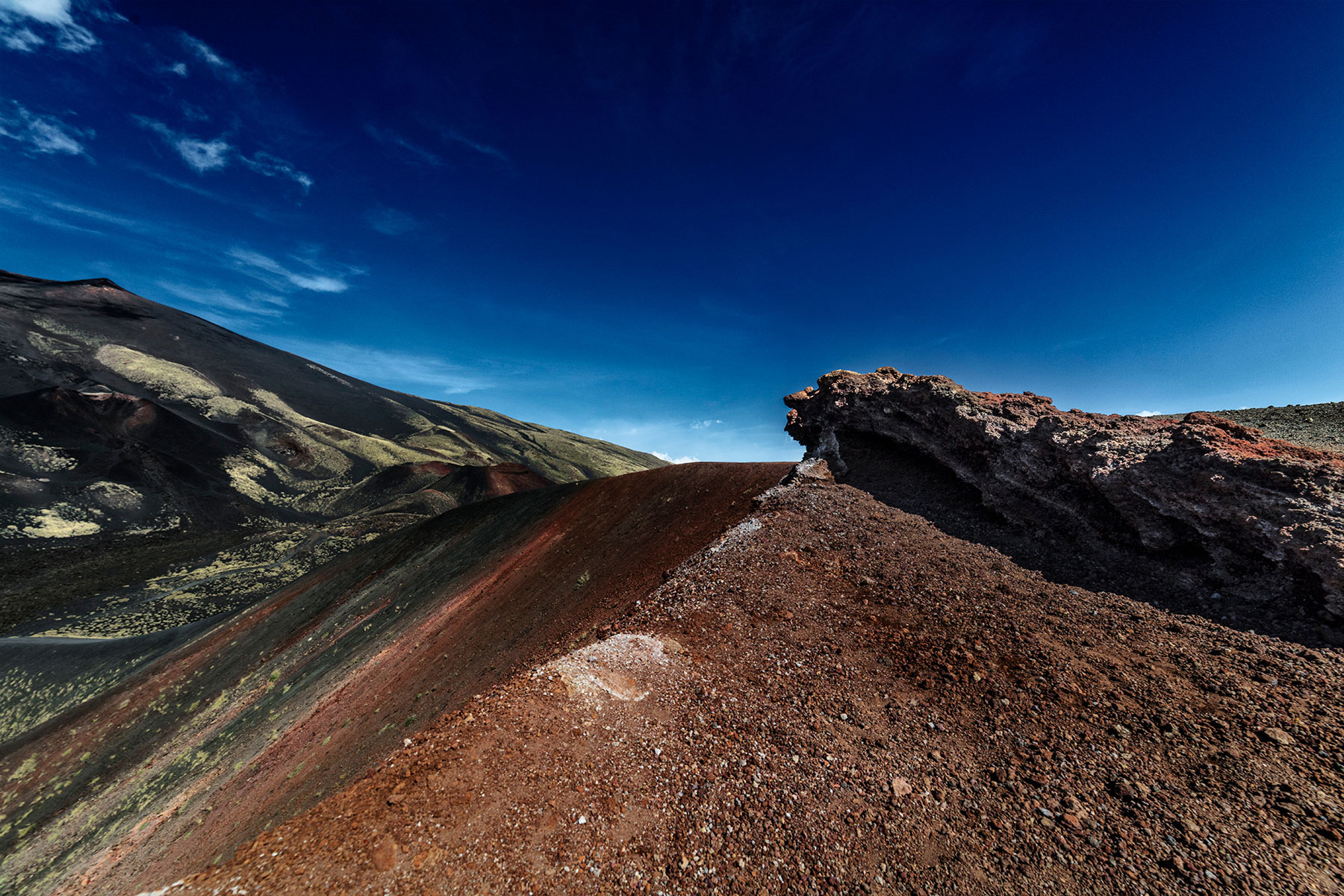
Catania
City of a thousand faces that makes its 28-century history weigh during which it was dominated by Greeks, Romans, Ostrogoths, Byzantines, Muslims, French and Spanish. Via Etnea is the road that runs through and divides the city. A walk through this street is enough to realize the extraordinary beauties that Catania offers and to understand the reason why the baroque of its historic center was declared a UNESCO World Heritage Site in 2002. To see the Collegiate, that is to say the Church of Santa Maria Santissima dell’Elemosina, whose baroque façade is wonderful. At the end of Via Etnea, Piazza del Duomo opens up which houses the Cathedral of Sant’Agata, the patron saint of the city. This cathedral, built in the second half of 1000, has been repeatedly destroyed by earthquakes and volcanic eruptions. In front of the Duomo, right in the center of the square, there is “u Liotru“, the elephant statue with the obelisk, the symbol of Catania. The work was realized in 1737 by the architect Giovanni Battista Vaccarini and represents the three civilizations: the Punic (the elephant is the symbol of the defeat of the Carthaginians), the Egyptian one (with the presence of the obelisk, brought to Catania at the time of the Crusades) and the Christian one, with the cross mounted on the obelisk. At the corner of this square is the Amenano fountain, which takes its name from the underground river that moves it and flows under the city. Just behind this fountain is the renowned fish market. In fact, until lunchtime, the square and the streets around are filled with benches and banquets with fishermen who sell their fish. The market is one of the most characteristic places in Catania. Walking through the streets of the center and admiring the many baroque churches you can taste the typical products. If you arrive in Catania you cannot miss a visit to Acitrezza, the seaside village that overlooks the Riviera of the Ciclopi where the Sicilian writer Giovanni Verga set “I Malavoglia”, his most famous novel. Catania offers an intense nightlife. The city shines with a thousand bistro lights, restaurants, taverns, jazz cafes and everything else you could want on a holiday evening that is the heat of August or a warm December. A large metropolis enclosed in a typical Sicilian seaside town.
Cathedral of Catania | © Simona Bonanno
Siracusa
The enchanting city was in its glorious past one of the greatest metropolis of the ancient world and the capital of the island in the Roman and Byzantine periods. Syracuse has an immense heritage from the historical, archaeological and landscape point of view and in 2005 it became a World Heritage Site together with the Rocky Necropolis of Pantalica. The Island of Ortigia is the oldest part of the city of Syracuse, the first to be inhabited. Here is the Duomo that was built in the 5th century BC C. as Temple of Athena later modified and transformed into a Christian basilica. Then again to admire the Archbishop’s Palace, the Church of San Martino and the Church of Santa Lucia alla Badia. Do not miss the temple of Apollo, considered the oldest in Sicily. It was built in the 6th century BC C. and over time has undergone various changes becoming church, mosque and still church, depending on the religion of the rulers. Under the Aragonese rule it was transformed into a barracks. Ortigia in the evening turns into an intricate maze of narrow streets that light up at the many restaurants and clubs that offer delicious typical dishes. You could stay several days to admire and fully understand the charm of Syracuse, to see and explore there are dozens and dozens of wonders like the Archaeological Park of Neapolis, the Greek Theater, the Eurialo Castle and the Ear of Dionysius. To explore also the splendid sea of the province of Syracuse. You can go as far as the Oasis of Vendicari, a nature reserve, which offers enchanting landscapes and a wonderful sea.
Syracuse | source: web CC0 Creative Commons

